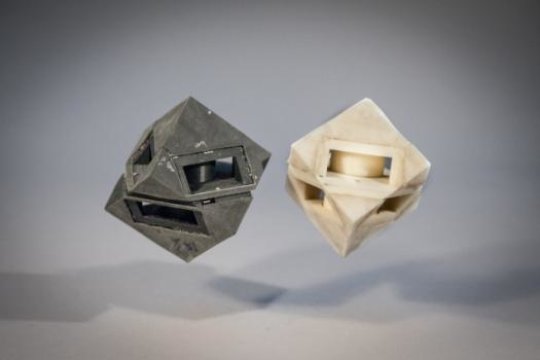If you’ve ever caught an episode of “Battle Bots” or watched drone videos, you know robots can break. Oftentimes this is because they don’t have the proper padding to protect themselves. Now, thanks to researchers at MIT’s Computer Science and Artificial Intelligence Laboratory (CSAIL), this is about to change.

MIT researchers outfitted their cube robot with shock-absorbing skins (left) that transfer less than half the energy that would normally be transferred to the ground. Image source: MIT.
Being all about 3D-printing soft materials, the new method makes robots safer and more precise in their movements. It could also be used to improve the durability of drones, phones, shoes, helmets, and more. Called “programmable viscoelastic material,” or PVM for short, the technique lets users program every part of a 3D-printed object to the exact levels of stiffness and elasticity they want, depending on the task they need for it.
One example would be 3D-printing a cube robot that moves by bouncing. Researchers outfitted such an object with shock-absorbing skins that use just 1/250 the amount of energy it transfers to the ground. According to CSAIL director Daniela Rus, the reduction makes all the difference for preventing a rotor from breaking off of a drone or a sensor from cracking when it hits the floor. “These materials allow us to 3D-print robots with visco-elastic properties that can be inputted by the user at print-time as part of the fabrication process,” Rus said.
The skins also allow the robot to land nearly four times more precisely, suggesting similar shock absorbers could be used to help extend the lifespan of delivery drones such as the ones being developed by Amazon and Google. The cube robot includes a rigid body, two motors, a microcontroller, battery, and inertial measurement unit sensors. Four layers of looped metal strip serve as the springs that propel the cube.
“By combining multiple materials to achieve properties that are outside the range of the base material, this work pushes the envelope of what's possible to print,” said professor of engineering at Columbia University, Hod Lipson. “On top of that, being able to do this in a single print-job raises the bar for additive manufacturing.”
Rus believes PVMs could have other protective uses, including shock-absorbing running shoes and headgear. By damping the motion brought about by robots' motors, for example, PVMs are not only able to protect sensitive parts like cameras and sensors, but can make the robots easier to control.
The work was supported by a grant from the National Science Foundation.
Source: CSAIL
Advertisement
Learn more about Electronic Products Magazine





